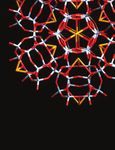Conformational Studies of ε- CBz- L- Lysine
←
→
Page content transcription
If your browser does not render page correctly, please read the page content below
ISSN: 0973-4945; CODEN ECJHAO
E-Journal of Chemistry
http://www.e-journals.net 2010, 7(3), 1013-1017
Conformational Studies of ε- CBz- L- Lysine and
L- Valine Block Copolypeptides
AJAY KUMAR
Guru Tegh Bahadur Institute of Technology,
G-8 Area, Rajouri Garden, New Delhi-110064, India.
ak.gupta59@rediffmail.com
Received 22 October 2009; Accepted 15 December 2009
Abstract: Conformational studies of ε-CBz-L-lysine and L-valine block
copoylpeptides using x- ray diffraction and CD spectra are described. The block
copolypeptides contain valine block in the center and on both side of the valine are
ε-CBz-L-lysine blocks. The conformation of the copolypeptides changes with
increases in the chain length of ε- CBz-L- lysine blocks. When length of ε- CBZ- L-
lysine blocks is 9, the block copolypeptide has exclusive beta sheet structure. With
the increase in chain length of ε-CBz-L-lysine blocks from 9 to 14, the block
copolypeptide shows presence of both alpha helix and beta sheet components. With
further increase in chain length of ε- CBz- L- lysine blocks, the beta sheet component
disappears and block copolypeptides exhibits exclusive α -helix conformation.
Keywords: ε- CBz- L- lysine and L- valine, Copolypeptides, x-Ray diffraction and CD spectra, α and
β conformation
Introduction
The synthetic polypeptides used as, synthetic silk fiber analogues, biocompatible materials
and in surface coatings, microphones, piezoelectric membranes are derivatives of amino
acids1-8. Random copolymers are fibrous and often have good mechanically strength9,10.
Sequential copolymer of amino acid are also fibrous have been studied as protein models11-13.
Block copolymers have been of interest because they potentially represent the simplest
model for globular protein14. In practice, the low molecular weight block copolymers
produce aggregates or micellar blocks15. The AxBxXx copolymers fold like a globular
protein with internal α-helical structure and external hydrophilic shell16-20. It has been shown
that block copolymers are able to self assemble into ordered nanostructure but random coil
nature usually suppress any further level of organization21.
The peptide based biomaterials may have potential application in tissue engineering, drug
delivery and biometric composite formation21-25. More recently poly amino acids and co-poly -
amino acids have been used for the preparation of biodegradable surgical dressing26,27. Recently
principles, applications and prospects of peptidic based biomaterial have been reviewed28,29 .1014 AJAY KUMAR
The solid state conformation and viscoelastic properties of high molecular weight triblock
copolypeptides of γ- Bzl-L- glutamate and L- valine or L-leucine have been studied7,10,30.
In this present paper, we describe synthesis and solid state conformational studies by
circular dichroism (CD) and X- ray diffraction of the (ε- CBz- Lysine) n –(Val-Val) -
(ε- CBz- Lysine)n. The intrinsic viscosity of block copolymers increases with increase in n.
The ε- CBz- lysine is α- former, where as L- valine is β-former. The block copolypeptide of
ε- CBz- lysine and L-valine the conformation change from β to α- helix.
Experimental
L- Valine, ε- CBz- lysine were purchased from Sigma Chemicals, ethylenediamine (Sarabhai
Chemicals) was triple distilled before use. Commercial grade solvent were purified and dried as
per literature31. Benzyl alcohol and 4 M phosgene solution in benzene were from Fluka. N-
carboxyanhydrides (NCA) of L-valine and ε-CBz-lysine were prepared by Goodman’s method32.
Synthesis of block co-polymers
L-Valine–N-carboxyanhydride was polymerized using ethylenediamine as initiator with
monomer (M) to initiator (I) ratio of 10 in benzene:dioxane (1:1 v/v). The concentration of
momomer was 21/ mg/mL and polymerization was allowed to proceed for 3 days. The
blocks of ε- CBz- lysine were polymerized over L-valine blocks with varying degree of
polymerization (M/I, 20, 30, 50 and 80) by adding appropriate amounts of ε- CBz- lysine
NCA. The polymerization was allowed to proceed for 7 days. The yields of block
copolymers were about 75-80%. The block copolymers thus obtained were fractionated
using, ether as a non solvent. To fractionate the block copolymers, 800-900 mg of
copolymer was dissolved in 25 mL of (9:1 v/v) CHCl 3: TFA mixture and ether was added in
three portions (40 mL, 20 mL and 50 mL). The first (40 mL) and third (50 mL) fractions
were discarded and only middle fraction was taken for further studies.
Amino acid analysis
Amino acid analysis of copolymer was done by following the relative integrated intensities
of phenyl signals of ε- CBz- lysine (7.2δ) and gem dialkyl group signals of L-valine (0.9δ).
For this purpose a Perkin Elmer NMR Model, R-32 spectrometer was used. 30 mg of the
copolymers were dissolved in 0.5 mL of trifluoroacetic acid or D-chloroform –trifluroacetic
acid mixture and their NMR spectra were recorded. To calculate the mole percent
composition, the integration of the phenyl proton, signal was divided by 5 (as there are five
protons in phenyl group) and integration of gem dialkyl group was divided by six. Then
from the sum of integration the mole percent of each amino acid was calculated. The degree
of polymerization “n” of ε- CBz- lysine was determine from amino acid composition
assuming the degree of polymerization of (Val-Val) = 5.
Intrinsic viscosity {ή}
A Ubbelhode viscometer was used to determine the intrinsic viscosity of polypeptides.
Solution of block copolypeptides were prepared in chloroform: TFA (19:1 v/v). The solution
were filtered through G-3 sintered glass crucible. The intrinsic viscosity was determined by
extrapolation of plots of reduced viscosity against concentration (Figure not shown). The
intrinsic viscosity was expressed in dL/g.
Circular Dichroism (CD) studies
A Jasco spectro polarimeter Model J-500 DP was used to record CD spectra. The unit was
appropriate standardized by using andosterone. The films for CD studies were casted formConformational Studies of ε- CBz- L- Lysine 1015
chloroform –trifluoroacetic acid (19:1) solution on a quartz plate, which were transparent to
UV down to 185 nm. CD was recorded from 240 nm to down 185 nm wave lengths.
X- Ray diffraction studies
A Philips (PW -1010) x- ray diffractometer was used. Samples for x-ray diffractions were
prepared by casting thick films from copolymer’s chloroform: trifluoroacetic acid (19:1 v/v)
solution, over glass slides. The films were oriented by stroking the solution by fine knife in
one direction as evaporation occurred. The films were then kept in vacuum desiccator for
two days. The following relationship was used to calculate dhkl values.
nλ
dhkl=
2 SinΘ
CuK radiation filtered with Ni film was used to record the diffraction pattern
from 2Θ =3 0 to 30 0 , the Bragg angle. A chart speed of 2Θ per minute was used.
Results and Discussion
The amino acids compositions, intrinsic viscosities and conformation data of all the block
copolypeptide are tabulated in Table 1. The intrinsic viscosity of ε- CBz- lysine and valine
copolypeptides increase from 1.5 to 6.20 dL/g as the chain length of ε- CBz- lysine blocks
increase from 9 to 57. The increase in viscosity of block copolypeptides showed increase in
molecular weight of copolypeptides which confirms the increase in chain length of ε- CBz-
lysine blocks. CD spectra of the copolypeptide are shown in Figure 1. The CD spectrum of
block copolypeptide with n=9 showed a band at 214 nm which is indicative of β-sheet
structure. The CD spectrum of block copolypeptide showed bands at 222 nm and a hump at
207 nm which shows the presence of both β - sheet and α - helical components. The CD
spectrum of block copolypeptide with n=26 showed broad band in the range of 207 - 222
nm, this exhibit the presence of both the β - sheet and α - helical components in the peptide.
The CD spectrum of block copolypeptide with n= 57 showed two separate bands at 205 nm
and 225 nm which shows the presence of exclusive α – helical conformation.
Table 1. Conformational Studies on (X) n (Val-Val)5(X)n.
Mole Ratio Conformation
Copolypeptide n {η}dLg-1
K V CD X- Ray, dhkl
64 36 9 1.50 β β 13.6+ 8.8+ 4.8(s)
73 27 14 2.10 β, α α , β 12.9(s), 4.85(s)
GVVG
84 16 45 3.20 α α ( β) 12.9 (s), 4.8 (m)
92 80 57 6.20 α α 12.9 (s) , 4.8(f)
S=strong, m=medium, f=faint, Poly-L-valine, 4.8 A o, Poly-CBZ-lysine 12.9Ao
The CD spectra indicate that a transition from exclusively β – sheet with n=9 system
to a mixed β- sheet and helical form occurred with n=14 system. The ellipticities of the Л–Л*
(205), n-Л* (225 nm) bands of n=26 and n=57, copolypeptides were nearly equal, indicating
that the β- sheet component if present at all is present as very minor component33.
x- Ray diffraction profile of (ε-CBz- lysine)n–(Val-Val)5–(ε- CBz- lysine)n films casted
from chloroform: TFA (19 : 1 v/v ) and are shown in Figure 2. The block copolypeptide
with n=9 shows a sharp diffraction at 4.8 o A dhkl and small diffraction at dhkl 13.6 oA and
8.8 oA indicating the presence of β-sheet structure. The block copolypeptide with n=14
shows diffraction of almost equal intensity at dhkl 12.9 oA and 4.8 oA indicating the presence
of both β- sheet structure and α–helical structure. The block copolypeptide with n=26 shows1016 AJAY KUMAR
a sharp diffraction at dhkl 12.9 oA and a broad diffraction at dhkl 4.8 oA suggesting the
presence of mainly α – helical structure in this system. The block copolypeptide with n= 57
diffracted strongly at dhkl 12.9 oA and very weakly at dhkl 4.8 oA indicating the presence of
exclusive α - helical structure in this system. The X- ray diffraction profile shows a
transition from exclusively beta form (n=9) to a mixed beta and left handed alpha form
(n=14, 26). The system, n=57 have almost alpha helical form34,35.
[θ], m deg
λ,nm 2θ
Figure 1. CD Spectra of ε-CBz-L-lysine Figure 2. x–Ray diffraction pattern of
and L-valine copolypeptides , spectra ε-CBz-L-lysine and L-valine
-; n=9, - - ; n= 14, -. - ; n= 26, -..-, n= 57. copolypeptides , -; n=9, - - ; n= 14 , -. - ; n=
26, -..-, n= 57.
Thus both CD and x- ray diffraction studies show that block copolypeptide having the
chain length of ε- CBz- lysine 9 crystallizes into exclusive beta sheet structure. When chain
length of ε- CBz- lysine increases to 14, the block copolypeptide has two domains and
crystallizes into mixed alpha and beta conformation. When the chain length of the ε-CBz-
lysine blocks is increased to 45, the CD spectrum indicates that copolypeptide crystallizes
into exclusive alpha helix and x- ray diffraction profile shows that the copolypeptide aquires
alpha helix conformation but small amount of beta sheet component is also present. With
further increase in chain length of ε-CBz-lysine blocks to 57, the copolypeptide crystallizes
exclusively into alpha helix.
Therefore using the above observations, block copolypeptides which either crystallize
into exclusive beta sheet structure, mixed beta and alpha structure or exclusive alpha helix
structure may be prepared for biomedical and other applications.
References
1. Gallot B, Adv Polym Sci., 1978, 29, 87.
2. Imanishi Y, Tanaka M and Bamford C H, Int J Biol Macromol., 1985, 7, 89.
3. Tanaka M, Mori A, Imanishi Y and Bamford C H, Int J Biol Macromol., 1985, 7, 99.
4. Tsutsumiuchi K, Avi K and Okada M, Macromolecules, 1997, 30, 4013.
5. Wang D and De Fang X, Macromolecules, 1997, 30, 5688.
6. Cornelissen J J L M, Fischer M, Sommerdijk N A J M and Notte RJ M, Science,
1998, 280, 1427.
7. Hayashi T, Watson A G and Anderson J M, Macromolecules, 1977, 10, 346.Conformational Studies of ε- CBz- L- Lysine 1017
8. Calvert P, Nature, 1988, 393, 309.
9. Hilter A, Anderson J M and Borkowski E, Macromolecules, 1972, 5, 446.
10. Uralil F, Hayashi T, Anderson J M and Hiltner A, Polymer Engineering and Science,
1977, 17(8), 515.
11. Anderson J M, Hilter A, Schodt K and Woods R, Biomed Mater Symp., 1972 , 3, 25.
12. Hilter A. Anderson J M and Baer E J, Macromol Sci Phy., 1973, 8, 431.
13. Anderson J M, Gibbons D F, Martin R L, Hilter A, and Woods R, Biomed Mater.,
Symp., 1974, 5, 197 .
14. Schelaad H, Adv Polym Sci., 2006, 202, 53.
15. Kim K T, Winnik M A and Manners I, Soft Matter, 2006, 2, 957.
16. Gratzer W B and Doty P, J Am Chem Soc., 1963, 85, 1193.
17. Lupu-Lotan N, Berger A, Katchski E, Ingwall R L and Seheraga H A, Biopolymers,
1966, 4, 239.
18. Sage H J and Fasman G D, Biochem., 1966, 5, 286.
19. Auer H E and Doty P, Biochem., 1966, 5, 1708.
20. Cosani A, Peggion E, Terbojevich M and Portolan A, Chem Commun., 1967, 930, 224.
21. Deming T T, Nature, 1997, 390, 386.
22. Wei-Chiang Shen and Ryser H J P, Mol Pharmacol, 1979, 16, 614-622.
23. Zupon B, J Pharm Sci., 1983, 72, 1323.
24. Rowland R, Nature, 1975, 255, 487.
25. Wlchek P, Makromol Chem Suppl., 1979, 2, 207.
26. US Patent No. 4892733.
27. US Patent No. 6673361.
28. Chow D, Nunalce M L, Lim D W, Simnick A J and Chilkoti A, Mater Sci Eng R
Rep., 2008, 62(4) ,125.
29 Schelaada H and Antometti M, Eur Phy J., 2003, E10, 17.
30. Hayashi T, Anderson J M and Hiltner P A, Macromolecules, 1977, 10, 352.
31. Weissberger A, Techniques of Organic Chemistry: Vol VII (Organic Solvents);
Interscience, N.Y. 1955.
32. Fuller W D, Verlander M S and Goodman M, Biopolymer, 1976, 15, 1869.
33. Fasman G D, Poly- alpha-amino acids, proteins model for conformational studies,
Marcel Dekker, New York, 1967.
34. Woody R W, J Polym Sci Macromol Rev., 1977, 72, 181.
35. Yamashita D, Yamane T, Ashida T, Yamashita S and Yamashita T, Polym J., 1979,
11, 763.Photoenergy
International Journal of
International Journal of Organic Chemistry International Journal of Advances in
Medicinal Chemistry
Hindawi Publishing Corporation
International
Hindawi Publishing Corporation Hindawi Publishing Corporation
Analytical Chemistry
Hindawi Publishing Corporation
Physical Chemistry
Hindawi Publishing Corporation
http://www.hindawi.com Volume 2014 http://www.hindawi.com Volume 2014 http://www.hindawi.com Volume 2014 http://www.hindawi.com Volume 2014 http://www.hindawi.com Volume 2014
International Journal of
Carbohydrate Journal of
Chemistry
Hindawi Publishing Corporation
Quantum Chemistry
Hindawi Publishing Corporation
http://www.hindawi.com Volume 2014 http://www.hindawi.com Volume 2014
Submit your manuscripts at
http://www.hindawi.com
Journal of
The Scientific Analytical Methods
World Journal
Hindawi Publishing Corporation
in Chemistry
Hindawi Publishing Corporation
http://www.hindawi.com Volume 2014 http://www.hindawi.com Volume 2014
Journal of International Journal of International Journal of Journal of Bioinorganic Chemistry
Spectroscopy
Hindawi Publishing Corporation
Inorganic Chemistry
Hindawi Publishing Corporation
Electrochemistry
Hindawi Publishing Corporation
Applied Chemistry
Hindawi Publishing Corporation
and Applications
Hindawi Publishing Corporation
http://www.hindawi.com Volume 2014 http://www.hindawi.com Volume 2014 http://www.hindawi.com Volume 2014 http://www.hindawi.com Volume 2014 http://www.hindawi.com Volume 2014
Journal of Journal of Chromatography Journal of International Journal of
Theoretical Chemistry
Hindawi Publishing Corporation
Catalysts
Hindawi Publishing Corporation
Research International
Hindawi Publishing Corporation
Chemistry
Hindawi Publishing Corporation
Spectroscopy
Hindawi Publishing Corporation
http://www.hindawi.com Volume 2014 http://www.hindawi.com Volume 2014 http://www.hindawi.com Volume 2014 http://www.hindawi.com Volume 2014 http://www.hindawi.com Volume 2014You can also read



























































